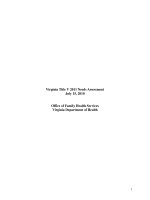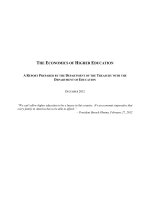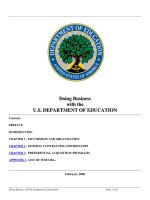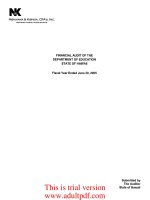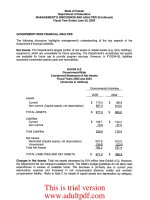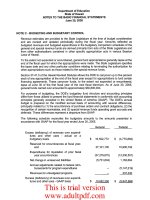West Virginia Department of Education
Bạn đang xem bản rút gọn của tài liệu. Xem và tải ngay bản đầy đủ của tài liệu tại đây (544.27 KB, 98 trang )
COLLEGIAL
COACHING
?
TOOLKIT
WEST VIRGINIA DEPARTMENT OF EDUCATION
West Virginia Department of Education
West Virginia Board of Education
2006-2007
Lowell E. Johnson, President
Delores W. Cook, Vice President
Priscilla M. Haden, Secretary
Robert W. Dunlevy, Member
Barbara N. Fish, Member
Sheila M. Hamilton, Member
Burma Hatfield, Member
Jenny N. Phillips, Member
Ronald B. Spencer, Member
Brian E. Noland, Ex Officio
Chancellor
West Virginia Higher Education Policy Commission
James L. Skidmore, Ex Officio
Chancellor
West Virginia Higher Education Policy Commission
Steven L. Paine, Ex Officio
State Superintendent of Schools
2
West Virginia Department of Education
Table of Contents
Topic
Page(s)
The Coaching Model Defined
The Coaching Model...............................................................................................1
Lessons from Research..........................................................................................2
The School Administrator...................................................................................5-10
Instructional Coaches />ItemNumber=5874&snItemNumber=950&tnItemNumber=951
Instructional Coaching Research
University of Kansas Center for Research on Learning........................................11
Professional Development Outcomes..................................................................12
Coaching Continuum Based on the Gradual Release of Responsibility..............13
Language for Coaching ........................................................................................14
Protocols for Setting Norms .................................................................................15
Protocols for Study Groups ..................................................................................16
Protocols for Questioning Techniques .................................................................17
Levels of Coaching Activities
Level I
National Staff Development Council Self Assessment and Planning Tool .....18-25
What is a Study Group? .................................................................................26-27
How Do I Conduct a Study Group? ................................................................28-30
Roles of Participants in Study Groups .................................................................31
Learner-Based Coaching .....................................................................................32
Assessment Instruments ................................................................................33-34
Level II
How Effective is Your Team? ...............................................................................35
Profile Assessment ..............................................................................................36
Role and Responsibilities Guidelines ..................................................................37
Team Meeting Planning .......................................................................................38
Team Mission Making ..........................................................................................39
Team Roles and Responsibilities .........................................................................40
Great Teams Engage in the Following Activities ............................................41-42
Quality Classroom Assessment ......................................................................43-45
Looking at Data to Determine if Student Learning Has Increased ......................46
3
West Virginia Department of Education
Level III
Teacher Modeling ...........................................................................................47-48
Teacher Modeling Strategies ..........................................................................49-61
Teacher Feedback Form ......................................................................................62
Recognition ..........................................................................................................63
Ways to Recognize Student Work .......................................................................64
Questioning ..........................................................................................................65
Elaborating, Hypothetical and Clarification Questions ........................................66
The Socratic Questioning Technique ..............................................................67-69
Modeling, Coaching and Scaffolding ..............................................................70-72
Using Scaffolded Instruction to Optimize Learning ........................................73-76
Coaching Plan
Collaboration: Essential Understandings ............................................................77
Collegial Collaboration: Practices that Promote School Success .................78-79
Co-Teaching .........................................................................................................80
Benefits of Co-Teaching For Teachers .................................................................81
Benefits of Co-Teaching for Students ..................................................................82
Do’s and Don’ts of Co-Teaching ..........................................................................83
Co-Teaching Approaches: An Overview ............................................................84
Co-Teaching Lesson Plan Considerations ...........................................................85
Looking at Outcome Data of Co-Teaching ...........................................................86
References ...........................................................................................................87
Tool Kit Development Committee
This tool kit was developed through the collaborative efforts of the following
individuals:
June Angle
Lori Ashcraft
Lynne Bostic
Rebecca Derenge
Dee Grimm
Barbara Jones
Anna Lewis
Jane Lynch
Kim Mathews
Vicki Nesler
Cynthia Nesselroade
Pat Porter
Nancy Richmond
Drexel Sammons
Debbie Smith
Jan Stanley
Sherri Woods
Paula Wykle
4
West Virginia Department of Education
The Coaching Model Defined
Recent studies on coaching (Neufeld & Roper, 2003; Poglinco, et al., 2003;
Richard, 2003) note that coaches may be specialized full or part-time
professional development facilitators, or they may be teachers making a career
transition from the classroom to coaching. Coaches frequently work one-on-one
with a teacher directly in the classroom and meet with the teacher before or after
a lesson. Student work is used as a springboard to discuss teaching strategies or
as help to plan next steps for instruction. Susan Poglinco et al. defines coaching
as "a form of inquiry-based learning characterized by collaboration between
individual, or groups of, teachers and more accomplished peers".
The professional development begins with subject specific training, focusing on
theory and instructional practice. Using a repertoire of effective instructional
practices, coaches collaborate with classroom teachers to identify practice(s) that
effectively address teachers’ and students’ needs. Through this process,
coaches work collaboratively with teachers setting professional goals for
developing, extending and improving research-based skills, strategies and
practices. Powerful instructional strategies make a profound difference for all
students when they are implemented by a skilled, caring and well-supported
teacher.
Coaches use a wide variety of professional development procedures to foster
extensive, high-quality implementation of interventions. These procedures
include (a) conducting individual or small group meetings to identify how best to
collaborate with a teacher/teachers in addressing their most pressing concerns,
(b) guiding teachers through instructional manuals, checklists and other
materials, (c) collaboratively planning with teachers to identify when and how to
implement intervention, (d) preparing materials for teachers prior to instruction,
(e) modeling instructional practices in teachers’ classrooms, (f) observing
teachers using interventions and (g) providing feedback (Knight, 2004).
11
West Virginia Department of Education
Lessons from Research
Instructional coaching is grounded in current research and clinical knowledge on
leadership and schools as “professional communities of practice”. Recent
research on professional development suggests that it is most effective when it
includes components that are based in the school and embedded in the job and
when it increases teachers’ theoretical understandings of their work (Miller 1995).
Supports for improved teaching and learning are also more effective when they
are tailored to needs identified by teachers and when their approach to learning
is collaborative and inquiry-based (Darling-Hammond and McLaughlin 1995).
Coaching provides such supports through an array of activities designed to build
collective leadership and continuously improve teacher instructional capacity and
student learning. These activities, ideally, coalesce in ways that create internal
accountability due to the embedded nature of the work and people engaged in it
(Barr, Simmons, and Zarrow 2003; WestEd 2000). A well-designed and
supported coaching program combines core elements of effective professional
development with the essential goals of professional learning communities in
ways that advance both school and systemic improvement.
The principles of instructional coaching are grounded in research on effective
professional development and professional learning communities. Coaching
appears to be a promising approach because it strives to blend what is known
about effective professional development with school-based and school-specific
needs, regarding both content and school climate.
Evidence of increased student learning as a direct result of coaching is not yet
well documented (Poglinco et al. 2003). Yet, as coaching is increasingly used
and its impact measured, researchers expect a direct correlation to be
established between coaching and student achievement. A growing body of
research suggests that coaching is a promising element of effective professional
development in some of the following ways.
The following paragraphs describe the positive effects of coaching:
• Effective coaching encourages collaborative, reflective practice.
Coaching shifts professional learning from direct instruction outside the context of
practice (such as workshops and conferences) to more varied opportunities to
improve discipline-specific practice. Most studies indicate that coaching leads to
improvements in instructional capacity. For instance, teachers apply their
learning more deeply, frequently and consistently than teachers working alone;
teachers improve their capacity to reflect; and teachers apply their learning not
only to their work with students, but also to their work with each other (Neufeld
and Roper 2003; Roglinco et al. 2003).
22
West Virginia Department of Education
•
Effective embedded professional learning promotes positive cultural
change.
The impact of coaching often goes beyond improving content
instruction. The conditions, behaviors and practices required by an effective
coaching program can affect the culture of a school or system, thus embedding
instructional change within broader efforts to improve school-based culture and
conditions (Neufeld and Roper 2003).
•
A focus on content encourages the use of data analysis to inform
practice. Effective coaching programs respond to particular needs suggested by
data, allowing improvement efforts to target issues such as closing achievement
gaps, supporting teachers across career stages, and advocating for equity (e.g.,
through differentiated instruction). A coaching program guided by data helps both
to create coherence within a school and to bridge different levels of the system
(Barr, Simmons, and Zarrow 2003). This is accomplished by focusing on
strategic areas of need that are suggested by evidence, rather than by individual
and sometimes conflicting opinions.
Coaches are selected from those
professionals who have the content expertise and organizational development
capacity to lead their “cadres” toward more effective practice in these areas of
need within various levels of the educational system.
•
Coaching promotes the implementation of learning and reciprocal
accountability. Coaching is an embedded, visible support, usually funded by
the district that attempts to respond to student and teacher needs in ongoing,
consistent, dedicated ways. The likelihood of using new learning and sharing
responsibility rises when colleagues, guided by a coach, work together and hold
each other accountable for improved teaching and learning (Barr, Simmons, and
Zarrow 2003; Coggins, Stoddard, and Cutler 2003; WestEd 2000). Because
instructional coaching takes place in a natural setting, the classroom,
observation, learning and experimentation occur in real situations (Neufeld and
Roper 2003).
• Coaching supports collective, interconnected leadership across a
school system. An essential feature of coaching is that it uses the relationships
between coaches, principals and teachers to create the conversation that leads
to behavioral, pedagogical and content knowledge change. Effective coaching
distributes leadership, supporting the goals of effective principals though the
coaches by keeping the focus on teaching and learning. This focus promotes the
development of leadership skills, professional learning and support for teachers
that target ways to improve student outcomes (Lyons and Pinnell 2001).
Research findings indicate that effective coaching structures promote a
collaborative culture where large numbers of school personnel accept ownership
and responsibility for leading improvement efforts in teaching and learning.
Coaching attends to the “social infrastructure” issues of schools and systems
(Payne 1998) that often impede the deep and lasting change that school reform
requires. These issues include school climate, teacher isolation, insufficient
33
West Virginia Department of Education
support and limited instructional and leadership capacity. The attempt to address
these critical elements of school quality by incorporating new understandings of
effective professional development is a primary reason that coaching holds
significant promise toward improving teaching and learning in schools (Neufeld
and Roper 2003).
Source: Neufeld, B., & Roper, D. “Coaching: A Strategy for Developing Instructional Capacity,
Promises, and Practicalities”
44
West Virginia Department of Education
April 2006
Features
Instructional Coaching
Eight factors for realizing better classroom teaching through support, feedback
and intensive, individualized professional learning
By Jim Knight
T he number of school districts using instructional coaches is growing at a
staggering rate. Coaching is becoming popular, in part, because many
educational leaders recognize the old form of professional development, built
around traditional in-service sessions for teachers, simply doesn’t affect
student achievement.
By offering support, feedback, and intensive, individualized professional learning,
coaching promises to be a better way to improve instruction in schools. Indeed,
preliminary research suggests that effective coaching programs make a difference.
For the past decade, researchers at the Kansas University Center for Research on Learning
have been implementing, refining and evaluating instructional coaching programs. In the
past year alone, our staff has provided professional development and consultation to
programs in 14 states across the country. We’ve learned a few lessons while developing,
studying and observing effective coaching programs. We believe superintendents and
other educational leaders who consider these success factors will be better able to use
valuable resources to realize the promise of instructional coaching.
No Quick Fix
Facing intense pressure to improve student achievement, it is tempting to try anything
that promises a quick solution. However, the trouble with quick fixes is they often make
things worse in the long run.
One common fix is what we refer to as the “attempt, attack, abandon cycle.” During this
vicious pattern, a new practice or program is introduced into a school and teachers make
a half-hearted attempt to implement it. Then, before it has been implemented effectively
and for a sufficient length of time, various individuals in the school or district begin to
attack the practice or program and, not surprisingly, many of the teachers implementing it
begin to lose their will to stick with the program. Eventually, even though it never had a
chance to be implemented properly, leaders in the district reject the program as
unsuccessful and abandon it, only to propose another approach that is soon pulled into
the same vicious cycle. In this manner, schools stay on an unmerry-go-round of attempt,
attack, abandon, without ever seeing any meaningful, sustained change in instruction
55
West Virginia Department of Education
taking place.
Instructional coaching represents one way to end this vicious cycle by providing sufficient
support for real change to occur. Coaching is a non-evaluative, learning relationship
between a professional developer and a teacher, both of whom share the expressed goal
of learning together, thereby improving instruction and student achievement.
Coaching requires a trusting relationship and sufficient time to provide the individualized
professional learning that is most relevant to a teacher’s needs. Coaches often employ
collaborative conversations (sometimes referred to as conferences), model lessons,
observations, and mutual problem solving to assist teachers in implementing and
mastering new teaching practices.
Coaching can take many forms. We have found eight factors that can increase the
likelihood that coaching will be a real fix for a school:
Sufficient time to work with teachers. To move a school forward, coaches must spend
the bulk of their time working with teachers on instruction. This seems obvious, but the
most frequent concern raised by the more than 300 instructional coaches we worked with
in 2005 was that they are asked to complete so many non-instructional tasks they had
little time left to work with teachers. Because coaches’ job descriptions are often vague or
nonexistent and because their schedules are more flexible than the schedules of others,
they often are asked to do many clerical or non-instructional tasks. Paying coaches to
copy and bind standards documents or shop for math lab furniture or serve as a substitute
teacher is a poor way to spend money and perhaps an even poorer way to improve
teaching practices in schools.
Some instructional coaches and principals in the 16,500-student Cecil County, Md., Public
Schools have found a way to ensure their instructional coaches use their time
productively. In Cecil County, where there is an instructional coach in each of the 17
elementary schools, the coaches and administrators draw up a pie chart that depicts
exactly how much time they agree the coaches should spend on various tasks. Then, each
week the coaches report to their principals how the time was spent. If necessary, this
allows the coach and principal to adjust the time allocations so they can focus their efforts
on improving instruction.
Proven research-based interventions. If instructional coaches are going to make a
difference in the way teachers teach, they need to have scientifically proven practices to
share. Hiring coaches but not ensuring they have proven practices is a bit like trying to
paint a beautiful painting without any art supplies. Instructional coaches need to have a
repertoire of tools to help them assist teachers in addressing their most pressing
concerns.
Instructional coaches working with the Center for Research on Learning use interventions
that address what we refer to as the “Big Four” areas of behavior, content knowledge,
instruction and formative assessment. The coaches develop a deep understanding of
scientifically proven practices they can share with teachers to help them improve in any or
all of the four areas.
If an instructional coach and teacher agree to address content knowledge, the coach
collaborates with teachers to develop critical questions, course and unit content maps and
concept diagrams using scientifically proven “content enhancement routines” developed
by Keith Lenz, Jan Bulgren and other researchers at the Kansas University Center for
Research on Learning.
66
West Virginia Department of Education
Similarly, if an instructional coach and teacher need to work on classroom management
tactics, the coach can use the classroom expectations planning sheets from Randy
Sprick’s “CHAMPs: A proactive and positive approach to Classroom Management” as a tool
for collaboratively developing a classroom management plan with the teacher. Among the
tools in CHAMPs is a framework coaches can use to identify and explain what they expect
from students in five important areas of behavior, encapsulated in the CHAMPs acronym.
The areas of behavior are: (a) Conversation — What kind of conversation is acceptable?
(b) Help —How should students ask for help? (c) Activity — What should the student be
doing? (d) Movement — What kind of movement, if any, is permitted? and (e) Participation
— What does appropriate participation look like?
Professional development for instructional coaches. Coaches need to understand the
interventions they are sharing, and they need to understand how to productively employ
the coaching process. Without their own professional development, instructional coaches
run the risk of being ineffective, wasting time and money or even misinforming teachers.
Therefore, coaches need to participate in their own professional development to ensure
they know how to coach and what to share when they coach classroom teachers.
Professional development for coaches should address at least two subjects.
First, coaches should engage in various professional learning activities designed to
improve their coaching practices. Specifically, instructional coaches affiliated with our
center learn how to employ powerful, proven practices to (a) enroll teachers in coaching;
(b) identify appropriate interventions for teachers to learn; (c) model and gather data in
the classroom; and (d) engage in dialogue about classroom and other data. Additionally,
the center’s instructional coaches improve their professional skills in areas such as
communication, relationship building, change management and leadership.
Second, professional development for coaches should deepen their knowledge about the
teaching practices they are sharing with teachers. Obviously, if coaches have a superficial
knowledge of the information they share with teachers, they will not know what to
emphasize when they discuss, model or observe during professional learning with
teachers. Indeed, coaches who do not deeply understand what they are sharing with
teachers could misinform teachers and actually make things worse, not better, for
students.
The Passport to Success statewide coaching program sponsored by the Maryland State
Department of Education Division of Special Education emphasizes professional learning
for coaches. Prior to starting their new role, the coaches receive two weeks of intensive
professional development focusing on the theory, practice, teaching strategies and
routines they will share with the teachers. Then, the Passport coaches participate in a
week-long summer institute where they deepen their knowledge of the teaching practices
they will share with teachers.
During the school year, the instructional coaches meet monthly with other coaches in a
coaching professional learning community, and they also participate in formal professional
learning sessions twice a semester. Additionally, Passport coaches read research articles
and complete many learning tasks that enable them ultimately to become certified
professional developers for the content enhancement routines and learning strategies
they share with teachers.
Protecting the coaching relationship. Many, perhaps most, teachers see their profession
as an integral part of their self-identity. Consequently, if coaches and others are careless
with their comments or suggestions about teachers’ practices in the classroom, they run
the risk of offending teachers, damaging relationships, or at the very least not being
77
West Virginia Department of Education
heard. Because teaching is such a personal activity, coaches need to win teachers’ trust.
Trust is an essential component of an open coaching relationship.
Coaches who learn our center’s approach to instructional coaching define their
relationship with teachers as a partnership. This partnership approach is based on the
assumptions that (a) coaches and teachers are equal partners, (b) teachers should have a
choice about what and how they learn, (c) teachers should reflect and apply learning to
their real-life practice as they are learning, (d) professional development should enable
authentic dialogue and (e) coaches should respect and enable the voices of teachers.
Sue Woodruff, a leader of professional developers from Grand Rapids, Mich., considers the
partnership principles to be a central part of her professional practice. “The principles
really help me think through what should happen when I work with teachers,” she says.
“On those occasions when I don’t feel I’ve been successful, I go back to the principles and
I usually discover that I failed because I violated one of the principles.”
To make it easier for coaches to work as partners with teachers, educational leaders must
protect the coaching relationship. If leaders ask coaches to hold the dual role of
administrator and coach, they put their coaches in a difficult situation. Administrators, by
definition, are not peers. Usually people are more guarded when they talk with their
bosses than when they talk with their peers. Coaches will find it easier to have open
conversations about teaching practices if their collaborating teachers do not view them as
bosses and, therefore, do not have to worry about how their comments might affect the
way they will be evaluated.
Ensuring principals and coaches work together. The instructional coach can be and
should be the right-hand person of the principal when it comes to instructional leadership
in schools, but the principal must remain the instructional leader. No matter how much a
coach knows, and no matter how effective a coach is, the principal’s voice is ultimately
the one most important to teachers. For that reason, coaches must understand fully what
their principals’ vision is for school improvement, and principals need to understand fully
the interventions that their coaches have to offer teachers.
One way to ensure principals get the most out of their instructional coaches is to provide
them with sufficient training. Principals who do not understand the importance of
protecting the coaching relationship may act in ways that make it difficult for a coach to
be successful. Also, a principal who is unaware of the tools that an instructional coach can
offer will be unable to suggest them to teachers who might benefit from learning them.
District administrators in Pflugerville, Texas, a district with three high schools, four middle
and 15 elementary schools, address this issue by providing coaching professional
development for administrators. In Pflugerville, middle and elementary principals, along
with the directors of special education, language arts, mathematics and technology,
attended sessions with their lead teachers and coaches to ensure that both administrators
and coaches developed a shared understanding of each coach’s goals, responsibilities and
methods.
Another way to ensure principals are on the same page as their coaches has been
adopted by principals working with instructional coaches from the center’s Pathways to
Success GEARUP project in Topeka, Kan. In Topeka, coaches and principals from six middle
schools and three high schools meet one-on-one each week for approximately 45 minutes.
The meetings usually follow the same format. First, the coach asks the principal to discuss
her or his most pressing concerns; the issues discussed are usually a blend of long- and
short-term issues that most interest the principal. Second, the coach and principal solve
88
West Virginia Department of Education
problems together. Third, the coach reports on what she or he has done since the previous
week’s meeting. Fourth, the coach and principal discuss teaching practices they would like
to share with each other. In this way, the coach and principal fully understand all the tools
they have at their command to help students.
Hiring the right instructional coaches. All the factors described here will not yield
success if the wrong people are hired as coaches. Indeed, the most critical factor related
to the success or failure of a coaching program may be the skills and attributes of the
instructional coach.
First, instructional coaches must be excellent teachers, particularly because they will likely
provide model lessons in other teachers’ classrooms. They also need to be flexible since
their job requires them to change their plans almost daily to meet the changing needs of
teachers.
In addition, coaches should be highly skilled at building relationships. In our experience,
whether a teacher adopts a new teaching practice has as much to do with the
instructional coach’s communication skills as with whatever intervention the coach has to
share. Simply put, if teachers like a coach, they usually will try out what the coach
suggests. If they don’t like the coach, they’ll even resist helpful teaching practices.
Jim Collins’ study of great organizations in Good to Great offers additional insight into the
desirable attributes of an effective coach. Great leaders, Collins writes, “are ambitious first
and foremost for the cause, the movement, the mission, the work — not themselves —
and they have the will to do whatever it takes to … make good on that ambition.”
The attributes Collins identifies in great leaders are also found in the best instructional
coaches. They need to be ambitious for change in their schools and willing to do, as
Collins emphasizes, “whatever it takes” to improve teaching practices. If a coach is too
passive about change, chances are that little will happen in the school. At the same time,
if a coach is too self-centered or aggressive, there is a good chance the coach will push
teachers away.
Effective coaches embody what Collins describes as a “compelling combination of
personal humility and professional will.” They are affirmative, humble and deeply
respectful of classroom teachers, but they are unwilling to rest unless they achieve
significant improvements in teaching and learning in their schools.
Evaluating Coaches
Evaluation is a major mechanism for continuous improvement of any coaching program.
Evaluating instructional coaches can offer unique challenges because no one in a district,
including the principal, may ever have been a coach before and there may be no
guidelines for evaluating coaches.
One way to address this challenge is to involve coaches in the process of creating
guidelines, standards and tools to be used for their evaluation. Instructional coaches and
the leaders of the Pathways to Success project in Topeka, Kan., have done just this.
Specifically, project leaders and coaches have collaborated to spell out in detail the
knowledge coaches need to have about the various scientifically proven teaching
practices they are sharing with teachers. Additionally, project leaders and instructional
coaches together have described the skills necessary to build relationships and effectively
execute the components of the coaching process.
Involving coaches in the process of writing their evaluation guidelines accomplishes at
least three goals. First, it enables school districts to develop a rubric for evaluating
99
West Virginia Department of Education
coaches that is especially designed for coaches. Second, it increases coaches’ buy-in to
the guidelines and process of being evaluated since they created them. Third, the
dialogue coaches have while creating the guidelines is an excellent form of professional
development.
Coaching Fixes
School district leaders can increase the likelihood that their instructional coaching
program will succeed if they ensure their coaches have sufficient time to work on
instruction with teachers and their coaches know how to coach and what to share with
teachers. Additionally, leaders can make it easier for coaches to succeed by protecting the
coaching relationship and by preparing coaches and principals to work together
effectively. Finally, the effectiveness and continual improvement of any coaching program
hinges on hiring the right people and evaluating them professionally.
Instructional coaching holds much potential for improving the way teachers teach and the
way students learn, but that potential will only be realized if leaders plan their coaching
program with care. Coaching is not a quick fix, but it can be a real fix — a powerful way to
help teachers and students be more successful. When planned carefully and when the
success factors are addressed, instructional coaching can begin to deliver on the promise
of making a real difference in schools.
Jim Knight is a research associate and the director of Instructional Coaching Institutes at
the Kansas University Center for Research on Learning, 1122 West Campus Road, Suite
508, Lawrence, KS 66045. E-mail:
Back to Top
View The School Administrator Archived Issues
1010
West Virginia Department of Education
Instructional Coaching Research Conducted by
University of Kansas Center for Research on Learning
To date, the University of Kansas, Center for Research on Learning, has focused
on these three questions:
1. Does coaching lead to successful implementation of instructional
methods?
2. Is fidelity to a program crucial to improving student achievement?
3. What do teachers think about instructional coaching?
Does coaching lead to successful implementation of instructional
methods?
The University of Kansas, Center for Research on Learning, indicates that
coaching does indeed lead to successful adoption and effective use of proven
instructional methods, with one crucial caveat: the right conditions, in the form of
administrative support and qualified coaches, must be in place. In schools in
which either of these elements is missing, implementation success rates are low.
•
Administrative support. The actions and expressed values of principals
and district decision-makers can determine the effectiveness of an
instructional coaching program. These two levels of administrative support
are critical to the success instructional coaches can achieve within a
school.
•
Qualified coaches. Instructional coaches must have a deep
understanding of the interventions shared with teachers. Beyond that
knowledge, experience has uncovered a less tangible array of personal
qualities that allow an instructional collaborator to succeed. Coaches are
master teachers who are comfortable in any classroom. They love children
and love working with children in schools. They possess energy and a
positive outlook, making them the kind of people others enjoy being
around. Above all, coaches are able to communicate a deep, honest belief
in teachers, even as they suggest ways for teachers to improve.
Is fidelity to a program crucial to improving student achievement?
Is it really important for teachers to teach in the manner described in an
instructor's manual? Does fidelity matter? Researchers at the University of
Kansas feel this is an important question to answer if fidelity is a central goal of
coaching. Researchers set out to determine how well students were achieving in
"hi-fi" classrooms--those in which teachers' practices closely followed those
outlined in instructional manuals--and "low-fi" classrooms--those in which
teachers left out significant components of practices outlined in instructional
manuals. Yes, the research does support that fidelity to a program does matter.
Coaching in the Context of Professional Learning Communities
Source: University of Kansas, Center for Research on Learning
Source: Showers, Joyce & Bennett, 1987
1111
West Virginia Department of Education
Instructional coaching is most effective when it occurs within a successful
professional learning community. At the heart of this community is a belief in the
need for continuous improvement, where a constant and collective search for
improving classroom instruction is conducted. The process of professional
learning includes:
•
•
•
•
•
Research, presentation and explanation of the theory behind the practice
Demonstration and modeling of instructional strategies
Opportunities for initial guided practice
Prompt feedback from guided practice
Sustained coaching for institutionalization of instructional practice
The chart below depicts the outcomes of different elements of professional
development: theory, demonstration, practice and coaching. Based on research,
an estimated 95% of teachers who receive ongoing support and guidance
through coaching are more likely to learn and implement new practices in the
classroom. Researchers also estimate that teachers generally need to utilize a
new instructional strategy approximately 25 times before it is transferred into their
daily teaching routine.
Professional Development Outcomes
Professional
Development
Elements
Theory
Knowledge Level
Skill Level
Transfer to
Practice
(Estimated percentage of
participants understanding
contents)
(Estimated percentage of
participants demonstrating
proficiency in the
instructional practices)
10%
5%
0%
30%
30%
0%
60%
60%
5%
95%
95%
95%
(Estimated percentage of
participants regularly
implementing instructional
practices in the classroom)
(e.g., presenter explains
content - what it is, why it is
important, and how to teach
it)
Demonstration
(e.g., presenter models
instructional practices)
Practice
(e.g., participants
implement instructional
practices during the
session)
Coaching
(e.g., participants receive
ongoing support and
guidance when the return to
the classroom)
Coaching Continuum For Coach/Teacher Engagement
A. Build
Common
Knowledge
Experience
Based
On The
Gradualand
Release
Of Responsibility
• Assist with teachers to align instruction to the WV Content
Standards and Objectives
• Encourage visits to other teachers’ classrooms
1212
• Organize study groups, workshops
and book studies
• Examine student work and assist teachers in adjusting
instructional strategies
West Virginia Department of Education
B. Commit to a Learning Relationship
• Model and demonstrate lessons while the teacher observes
• Use research to support instructional decisions
• Assist with assessing students
• Establish collaborative relationships with teachers
C. Coach/Teacher Build a Co-Teaching Relationship
• Use results of both formal/informal assessment to co-plan
lessons and adjust instructional strategies
• Assist in the development of plans the coach and teacher will
follow
• Continue collaborative relationships with all teachers
D. Teacher Transitions to Guided Practice with Coaching Support
• Conduct a pre-visit conference
• Co-teach or model lessons
• Visit classrooms and provide feedback for teachers from
observing students
• Conduct lesson studies with teachers and assist teachers in
analyzing student work
E. Teacher Refines Implementation with Coaching Feedback
• Observe teacher practicing research based instructional
practices
• Conduct a post-visit conference
• Participate in reflective lesson review and planning
• Use data to continue to make instructional decisions
• Sustain and continue collaboration with teachers
Source: Larner, Margorie, “Pathways: Charting a Course for Professional Learning”
1313
West Virginia Department of Education
Helpful Language to Use in Coaching Conversation
1. It’s wonderful to step into this classroom and see (point out specifics).
2. I noticed that more attention is paid to the front of the room.
3. The children were (engaged, working, etc.) except for . . . Why do you
think that was happening?
4. After the students viewed the video, what were you hoping would happen
next?
5. When I was watching, I was excited about your questioning technique.
6. What has happened lately that you felt really excited and pleased about?
7. The students were really learning actively when they divided the
assignment…Does that fit with your sense of what was going on?
8. Students were really learning actively when . . . Does that fit with your
sense of what was going on?
9. How did you know that students were understanding?
10. Can you help me understand what was happening when the two students
were allowed to go to the gym?
11. Try (a specific action or technique) and let me know how it works.
12. Try this (book, idea) and give me some feedback on how it went.
13. What are your priorities for these children?
14. What do you want these children to be able to do in (time period)?
15. Did students perform as you expected today?
16. Tell me about (child, event, book).
17. I was impressed with the children’s (independence, enjoyment, oral
discussion, reading, writing, etc.). What helped them learn that?
18. It appears that you are really enjoying these children. How is this group
different?
19. I was listening to the respectful way children talk to one another. What
did you do to help achieve this?
20. You seemed concerned about (event, child, time, etc.). Can you talk
about it?
21. I thought (child) was (attitude, behavior, etc.). Is that right? Can you tell
me more?
22. How can I help you in your teaching? (I have a suggestion. Tell me what
you think).
23. Students were roaming around the room. Is that typical?
24. You selected the same students for every activity. Can you talk about
your decision?
25. Was this a typical (morning, reading, group, lesson, etc.)?
Source: Lyon, C. & Pinnell, G.S., “System for Change in Literacy Education”
1414
West Virginia Department of Education
Protocols for Setting Norms
Purpose of Norms
The purpose of establishing norms is to curtail some unproductive behaviors (i.e.,
“Don’t monopolize the airtime.”) Norms also allow participants permission to be
bolder than what one might otherwise be (i.e., “Take some risks here.”)
Additionally, norms remind individuals that people learn in different ways (i.e.,
“Give everyone time to think.”) Norms are useful when newcomers arrive after
the work of the group is already underway (which happens frequently in
professional learning groups). When newcomers arrive, norms provide an
update of the group expectations. Norms are also useful when in addressing
“tricky” conversations that are frequent in real-life groups.
Steps 1. Brainstorming. The facilitator encourages the group to brainstorm all
possible norms, and lists the offerings on chart paper. The process of
setting norms begins with a few moments of silence as participants
consider what is essential for cooperative group functions. The facilitator
also participates in the brainstorming, adding whatever seems lacking for
the emerging lists – for example, “We want to create a place that is safe
enough in order for us to endure discomfort,” or “We want to be allowed to
take a risk.”
2. Discussion. The facilitator says, “So far this is just a brainstormed list-we have not yet agreed to it. Is there something which needs discussion,
which you want to question?”
3. Synthesis. In a transparent way--that is, voicing his or her deliberations
aloud--the facilitator synthesizes and fine-tunes: “I think that what I’m
hearing is that we want to be assured that good judgment will prevail.
There can be situations where a phone must be left on, and we don’t want
to prevent that when needed. On the other hand, we don’t want a number
of phones ringing. So maybe the norm should be that we will only leave
phones on when our judgment tells us we must. This is good. I was going
to just say, ‘No phones,’ but this is much better.”
4. Consensus. Noting that consensus means that all group members can
live with and support the norms, the facilitator moves the group to affirm
the list.
Source: Sweeney, Diane, “The Power of Protocols”
1515
West Virginia Department of Education
Protocols for Study Groups
The study group is many times the first experience that teachers have in this type
of professional development. Thus, it is essential to begin by defining how the
group chooses to function as a learning community.
Basic rules for study groups consist of the following. The learning community
will:
•
•
•
•
•
•
•
•
•
•
Establish a safe and secure environment/culture;
Address the self-interests of group members;
Develop a clear set of norms;
Engage in shared leadership;
Encourage mutual respect;
Provide productive and fun time together;
Identify a flexible shared vision;
Provide opportunities for members the chance to really know each other;
Celebrate various learning opportunities;
Respect differences and opinions of all group members.
Norms to follow in the learning community:
• Listen to each other without interrupting;
• Maintain a nonjudgmental attitude;
• Accept responsibility for your own learning;
• Honor the other learners in the group;
• Consider all questions to be safe questions;
• Participate willingly and actively;
• Prepare before attending the study group.
Source: Sweeney, Diane, “The Power of Protocols”
1616
West Virginia Department of Education
Protocols for Questioning Techniques
When using protocols, is it very important to consider questioning techniques.
Questions are distinguished as two types: clarifying questions and probing
questions. Characteristics of the two types of questions are described below.
Clarifying questions:
• Designed to assist responders in obtaining a complete picture of the
question by providing factual information.
• Include these sample questions:
o What did you do before this particular lesson?
o What was your goal for the lesson?
o How many students do you have?
o What is the students’ educational background?
Probing questions:
• Projected to assist the group to think more deeply about the dilemma;
• Requires practice;
• Several purposes are identified for probing questions:
o Help uncover a belief rather than a solution;
o Create depth in conversation;
o Reinforce that a culture is being created to learn together;
o Move the presenter into new territory;
o Assist the group to move beyond the original insight; and
o Lead to an “aha”.
Construction of probing questions involves the following actions:
• Preparing questions before answering them;
• Verifying that no “right” answer is identified. If so, delete judgment from
the question or don’t ask it;
• Referring to the presenter’s original question; and
• Checking to see that you are staying within the presenter’s agenda.
Source: Sweeney, Diane, “The Power of Protocols”
1717
West Virginia Department of Education
National Staff Development Council Self-Assessment and Planning Tool
Groups may use this self-assessment to determine the current state of
implementation of the context, process, and content of effective staff
development in their schools. The assessment may be used to reveal strengths
as well as areas for improvement.
Because of the value in obtaining multiple perspectives, the self-assessment is
most useful if completed by a group rather than individually.
Directions for using the NSDC Standards Self-Assessment
1.
Individual work.
Time: One hour.
(Note: In preparation for this, the facilitator should make individual copies
of the Self-Assessment for group members.)
Distribute copies of the Self-Assessment. Ask each group member to
complete the Self-Assessment alone. Time: 30 minutes.
Have participants compare their individual scores and discuss similarities
and differences. Time: 30 minutes.
2.
Group work.
Time: One hour.
(Note: In preparation for this, the facilitator should make two poster-size
copies of the scoring guide.)
After individuals have had time for small group discussions, assemble the
whole group.
Post one copy of the scoring guide on the wall of your meeting room.
When group members have completed their individual scoring, ask them
to transfer their scores to the scoring guide. Group members could do this
by making hatch marks, posting colored dots, making X’s in the
appropriate places of using any other method the facilitator devises.
The facilitator should count the number of group members who gave each
score to the various questions. For example, in question #1, how many
group members gave your school a score of 5? How many group
members gave your school a score of 3?
Transfer those numbers to the second copy of the scoring guide. Post this
copy of the scoring guide on the wall.
1818
West Virginia Department of Education
Since there are two questions for each standard, the facilitator may want
to combine the scores for those two questions. Do not attempt to average
the scores. Instead, ask the group to look for patterns in the numbers.
The facilitator may want to rank the standards in ascending or descending
order to give group members a graphic display of which standards they
need to address first.
At the conclusion of the group discussion about the scores, the group
should prepare an action plan based on it findings.
Source: National Staff Development Council
1919
West Virginia Department of Education
Self-Assessment: School Staff Development
Strongly Disagre Somewha
Disagre e
t
e
Agree
Context
1. Staff development is
ongoing and jobembedded.
2. Staff development
activities result in changes
in classroom practice for
most teachers on the staff.
3. The budget allocation
supports ongoing
professional development.
4. There is widespread
support for professional
development among
administration, teachers,
parents, school board
members, and other
influential members of the
community.
5. Staff development is
viewed as an essential
component for achieving
the purpose of the
organization and is valued
as an integral part of the
strategic plan.
6. Central administration
supports the work
necessary to accomplish
school improvement goals
and provides an adequate
budget.
7. Strategies for facilitating
planning and learning
during the school day exist.
8. A minimum of 20 percent
of the work week is devoted
to joint learning and work.
9. The school staff is
organized into study groups
to learn about the change
process and/or about
Agre
e
Strongl
y
Agree
1
2
3
4
5
1
2
3
4
5
1
2
3
4
5
1
2
3
4
5
1
2
3
4
5
1
2
3
4
5
1
2
3
4
5
1
2
3
4
5
1
2
3
4
5
2020
West Virginia Department of Education
particular innovations.
10. Teachers are observed
randomly to determine their
use of an innovation and
the innovation’s effect of
students.
Process
11. The school’s
improvement plan
addresses important
aspects of organizational
effectiveness such as
decision making,
communication, and team
functioning.
12. Information about
systems thinking and the
change process are used in
making school
improvement decisions.
13. The principles of adult
learning permeate staff
development.
14. The learning climate of
staff development activities
is collaborative, informal,
and respectful.
15. The three phases of
the change process are
initiation, implementation,
and institutionalization in
the planning of programs.
16. Staff and
administration are aware of
the “implementation dip”
(things often get worse
before they get better.)
17. Staff development
decisions are based on
data regarding valued
student outcomes.
1
2
3
4
5
Strongly
Disagre
e
Disagre
e
Somewha
t
Agree
Agre
e
Strongl
y
Agree
1
2
3
4
5
1
2
3
4
5
1
2
3
4
5
1
2
3
4
5
1
2
3
4
5
1
2
3
4
5
1
2
3
4
5
2121


